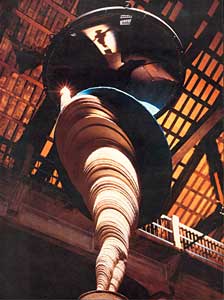Marco Bagnoli
"Though it be night"
Marco Bagnoli (Florence 1949) is one of the most outstanding artists on the contemporary visual arts scene in Italy. His oeuvre began in the seventies, characterised by a search for what esoteric knowledge has contributed to our western culture and an exploration of the boundaries to our way of seeing and scientific statement. His work embodies his personal philosophical proposal, which in 1975 led him to title one of his first solo exhibitions Spazio x Tempo and to include items drawn from the realm of science and alchemy. The referential world constituted by his creations explores the memory of culture and art, from mythological and classical manifestations to more contemporary ones. Marco Bagnoli studied Chemistry at the Scuola Normale Superiore in Pisa, and in his artistic work scientific questions have been a recurring feature as a sign of the spiritual condition of the West, a territory not to be rejected but to be understood in its metaphysical sense. Reflection on art in which science and spirituality are mutually reflected is the pervading theme in his work. Florence also exerts a strong influence, characterised by a combination of magic and scientific spirit proper to the Renaissance period, which he interprets as the transition from an age of tradition to an age of science. He re-examines the great themes of modern science -the theory of relativity, the uncertainty principle, Moebius’s ring- and integrates them into his artistic explorations, making them part of his pieces. Subjects such as the force of gravity are reconsidered from various viewpoints in Bagnoli’s work. Sometimes gravity is incorporated as a constituent part of the pieces, sometimes his works point to the process of research that accompanies attempts to overcome it, such as the works that allude to balloons, among which is the piece titled Mongolfiera in reference to the inventor, which is included in the IVAM exhibition. Integration into architectural space and the dialogue between the work of art and architecture have been constant concerns for Marco Bagnoli, who adapts his installations to the various exhibition spaces where they are shown. This was seen in early exhibitions such as Spazio x Tempo (1975), Vento d’Etere (1978) and Anti Hertz (1979), or in his project Iperborei (Hyperborean), in which the same title and different items were used to present a cycle in Perugia (1980), Amsterdam (1980) and Genoa (1981), with a constant interest in questions such as sight/vision, sound, light, place/non-place and speed/motionlessness being combined with different proposals in each of the three installations. Marco Bagnoli has taken part in almost all the major events that have marked the development of contemporary art in Europe, such as Documenta in Kassel (1982) and the Biennale in Venice (1982 and 1986), as well as appearing in numerous European exhibitions, including Identité italienne. L’art en Italie depuis 1959, Centre Georges Pompidou, 1981; The European Iceberg. Creativity in Germany and Italy Today, Ontario 1985; and Europa oggi. Arte contemporanea nell ‘Europa Occidentale, Museo de Arte Contemporaneo de Prato, 1988. In 1991 he exhibited at Le Magasin, Centre National d’Art Contemporain de Grenoble, and in 1996 the Museo Pecci in Prato devoted a retrospective to him. For the present exhibition the IVAM has published a catalogue with essays by Germano Celant, Emmanuel Guigon and the artist himself.



